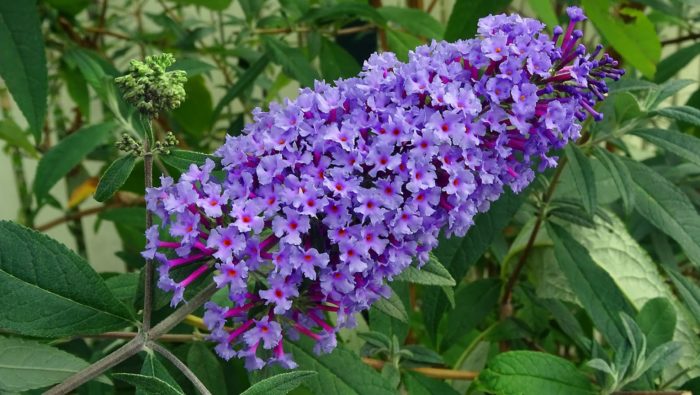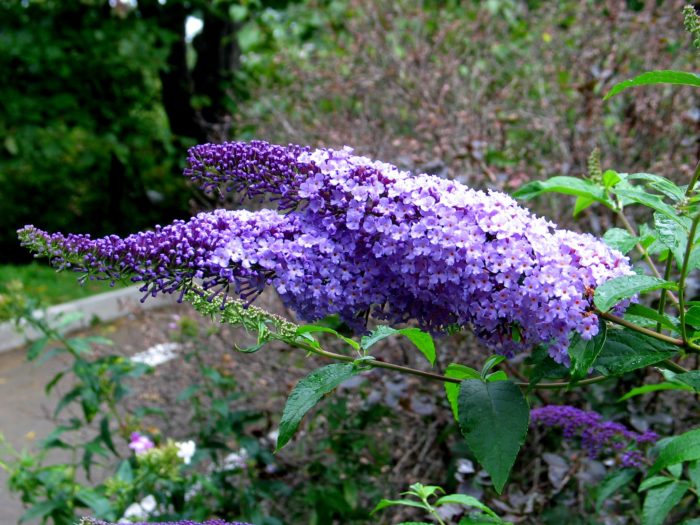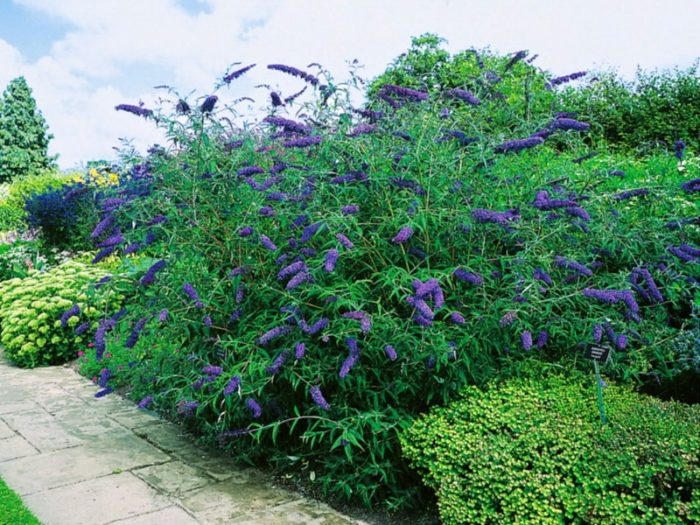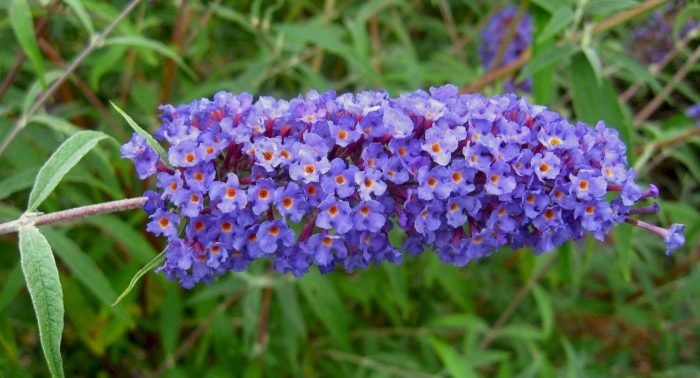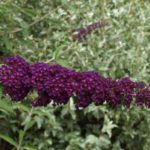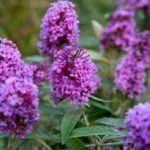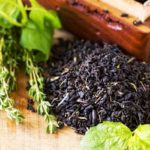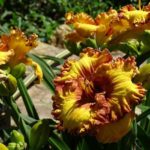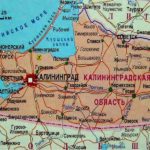This amazing flower called Buddleia Davida of the Nano Blue variety is a real decoration of the garden. Butterflies flock in swarms to this plant, which gives the blooming garden a fabulous look. Despite the fact that the plant looks exotic, it easily takes root in temperate climates. Let's talk about this beautiful ornamental plant, the intricacies of its planting and subsequent care. We will also look at how gardeners use Buddleia.
Description and history
The plant was brought to Britain by botanical explorer René Franchet, and another early eighteenth-century scientist named Adam Buddle. Later, the shrub was discovered in China by researcher Arman David.The plant is popularly called a butterfly bush due to the fact that fluttering butterflies flock to it. The David Nano Blue variety was developed in the United States at the end of XX century. Additional variety names: Nanho Petite Indigo, Nanho Petite Plum.
Buddleia is an ornamental deciduous shrub. Gardeners call it a flowering perennial. It reaches a height of one to two meters. The root zone of the Nanho Blue variety requires careful handling, as it is quite fragile. The shoots form into a funnel-shaped crown, also spreading up to one and a half to two meters. The arched, strong, medium-leaved branches of the flower grow quickly. In central Russia, this subshrub is grown as a perennial. In winter, the perennial stems freeze and die, but the roots survive. In warm regions of the country, the stems are located low to the ground. In this case, they should be pruned to encourage the appearance of spring shoots.
The leaves of the plant are elongated, lanceolate, have a pointed end and a narrow, spear-shaped opposite arrangement. The length of the leaf blade is ten to twenty-five centimeters, the color above is dark green, similar to the color of sage, and below it has a gray tint due to dense pubescence. In warm autumn, the foliage of the plant does not fall off for a long time.
It is important to remember that this variety is short-lived and blooms for about ten years, so it is advisable to propagate it in advance. Inflorescences of blue or blue-violet color are located on the tops of the shoots. The length of the flower plumes of the Nanho Blue variety reaches from twenty to thirty centimeters. The size of the panicles depends on how fertile the soil is. The plant requires moderate watering.You need to place the plant in a well-lit area - this way it can develop fully and form large inflorescences with corollas of a rich blue hue. The flowers attract butterflies and other pollinating insects.
The plant blooms in the third year of development. First, inflorescences appear on the main shoots, and then on the lateral ones. In the southern regions, gardeners already collect Buddleia seeds in the fall, but in the middle zone they often do not have time to ripen. Faded panicles are cut off so that the perennial continues flowering and does not waste energy on seed formation. In regions with warm winters, the plant can become a self-sowing weed.
Planting a plant
As a rule, the Nanho Blue variety is purchased in containers, selecting a seedling with swollen buds or elastic leaves. Planting is carried out in the autumn a month before the onset of frost or in early spring on a cool, cloudy day. When planting, you should adhere to the following rules:
- Choose only a sunny place located on the southwest or south side and protected from the wind.
- Use alkaline, slightly acidic or neutral soil.
- Leave a gap of one and a half to two meters between the bushes.
- Make holes fifty to sixty centimeters deep and wide.
- Prepare a substrate from garden soil with the addition of clay or sand, depending on the predominant components of the soil.
- Place the Buddleia root collar at surface level.
Aftercare
Buddleia planting material should be watered moderately and the tree trunk should be mulched, thus maintaining soil moisture. Loosening the soil should be shallow, since the roots are located close to the surface.In the evening hours you can spray the bushes with warm water. In spring and early summer, nitrogen fertilizers are used. Before flowering, it is recommended to feed Buddleia with fertilizers that contain potassium and phosphorus.
When a perennial is moved to another place for wintering, it is recommended to trim the stems in containers. In March, weakened shoots should be removed. In the first spring, the stems should be shortened by half; in the second spring, the growths should be shortened to two buds to form bushes.
Preparing for winter
This plant can withstand medium frosts with short-term temperature drops of up to 20°C. The plant is capable of overwintering in an open area in areas where prolonged frosts below twenty degrees are rare. If the climate is more severe, then it is advisable to move the Buddleia indoors in a special container. Gardeners using the transfer method should remain extremely careful not to damage the root system of Buddleia Davida. In this case, the lump of earth from the container is preserved and the plant is moved into open ground along with it. Two to three years from the moment of planting the seedling - Buddleia should form in a container and in the garden; gardeners only need to deepen the container in a prepared hole.
In the autumn months, Buddleia is pruned and mulched. The mulch layer consists of humus or peat and foliage up to fifteen centimeters. Next, you need to cover the plant with burlap or agrofibre, and cover it with snow in the winter months. It is important to understand that Buddleia may not survive the transplant.
The plant loves bright areas, and is able to demonstrate all the beauty in an area that is illuminated by sunlight all day.Large inflorescences of the bush feel safe when the plant is planted where the piercing wind does not pass. With regular watering, the plant blooms much more luxuriantly and longer. The main thing is not to overdo it with watering, because with high humidity this variety quickly withers.
Pest Control
There is no special need to protect Buddleia Davida, as this plant is not susceptible to mycotic infections. At the same time, sometimes the roots in warm regions suffer from round wombs - nematodes, and the leaves can be attacked by spider mites and aphids. Gardeners eliminate aphids with folk remedies such as baking soda and soap. And you can get rid of spider mites using acaricides: Sunmite, Masai and Oberon.
Reproduction
There are two ways to propagate this plant - using seeds or cuttings.
To use the propagation method through seeds, you need to have specialized equipment and professional skills. Indeed, in this case, for the plant to germinate, you need to control the lighting conditions and temperature. In this case, as a rule, only half of the seeds germinate, and only a part of them will continue to develop. The plant's seeds are planted in pots in February and transferred to open soil in May.
Cuttings are a much easier and more reliable method of propagation. You need to follow these tips:
- Cut off the top, strong young shoots in late spring or early summer.
- Leave up to 14 centimeters, removing the lower leaves.
- Place the seedlings in a substrate of soil and sand.
- Install a film dome on top.
You need to water the plant moderately, do not over-moisten the soil, but also do not allow it to dry out. Roots appear in about a month. As soon as this happens, you need to remove the cover.Next, transplant the cuttings into pots and leave them in a cool room for the winter, at temperatures above 0 °C.
Application
The fragrant plant attracts the attention of gardeners, who use it to decorate their gardens. A magnificent, fragrant plant, planted as a backdrop for beautiful, vibrant flowers such as roses. The graceful foliage and lush plumes of Buddleia Davida allow it to be planted along the perimeter of borders. Abundant flowering begins in July, when the plant turns into a real attraction. Also, some gardeners deliberately do not prune the plant in order to create a tall hedge from it.
Buddleia Davida variety Nanho Blue is a beautiful flower to decorate the garden. This bush is unpretentious to the composition of the soil, but at the same time it needs to be provided with a sufficient amount of sunlight. It takes root well in moderately dry soil and does not tolerate high humidity. Feeding the plant will help ensure lush flowering.

